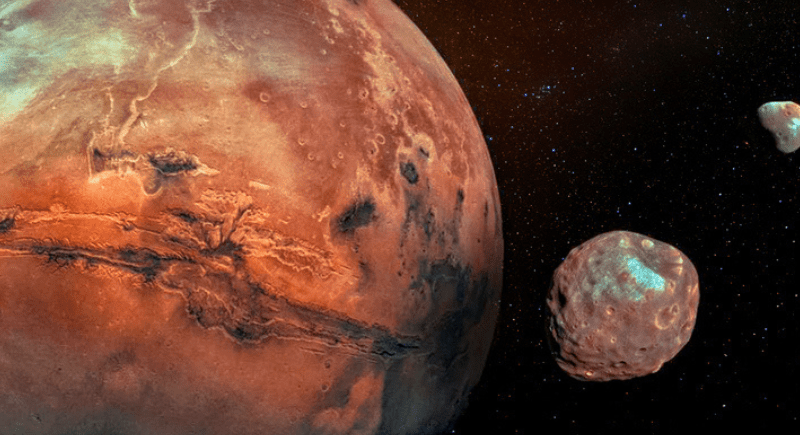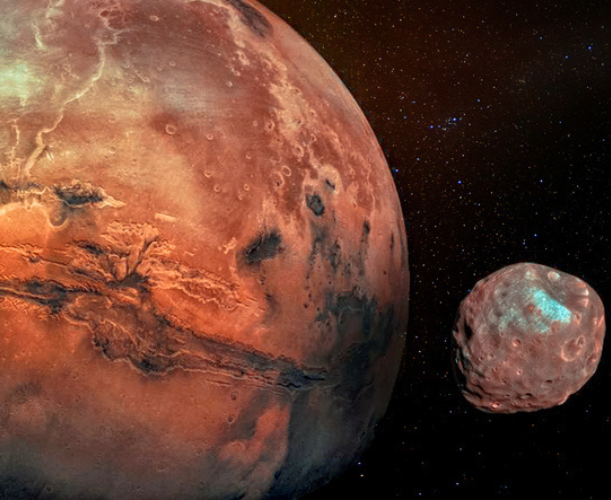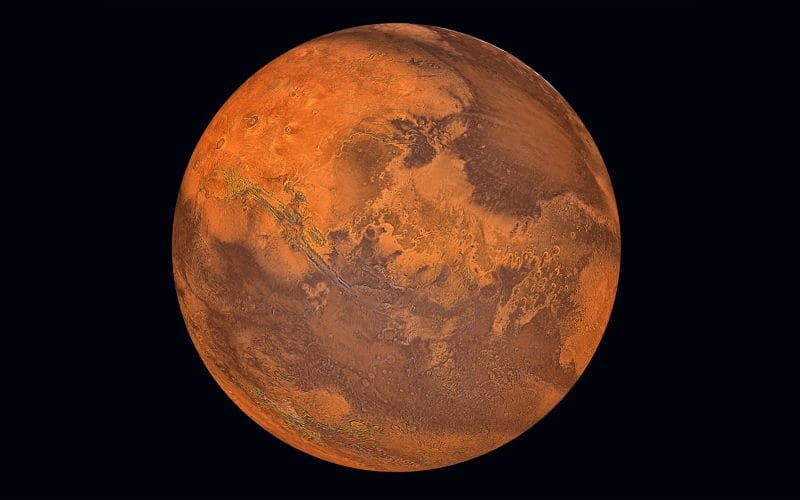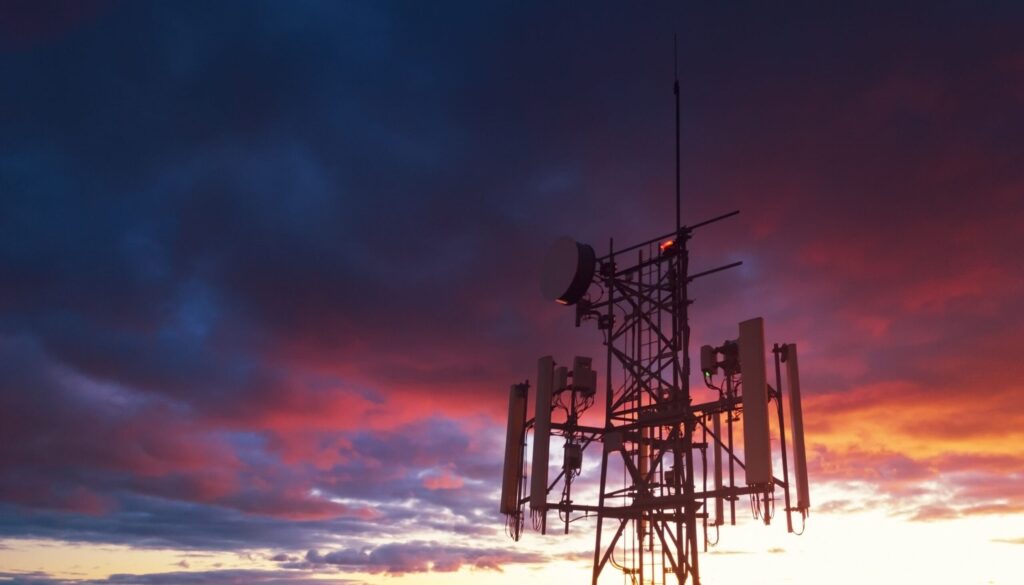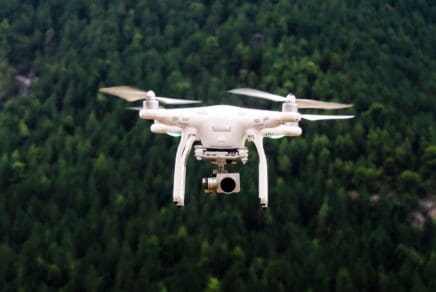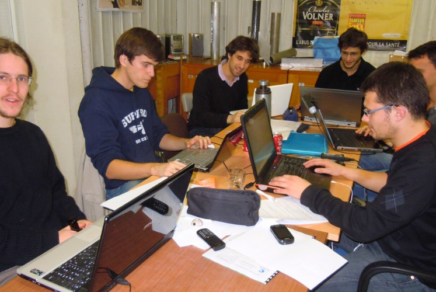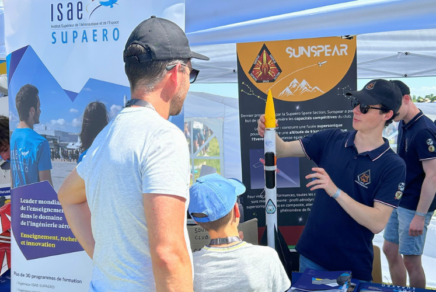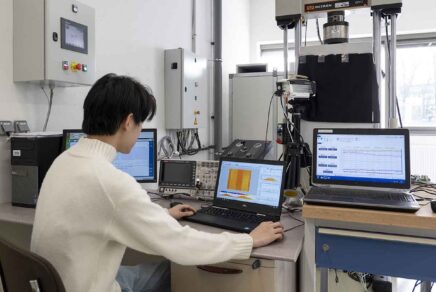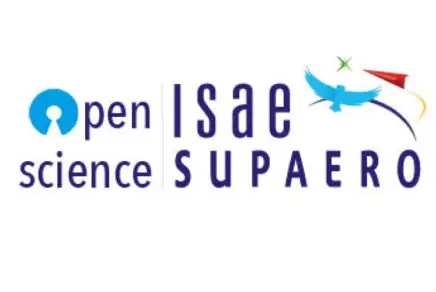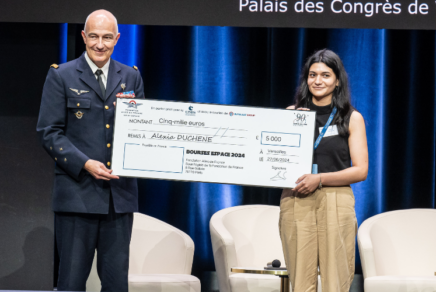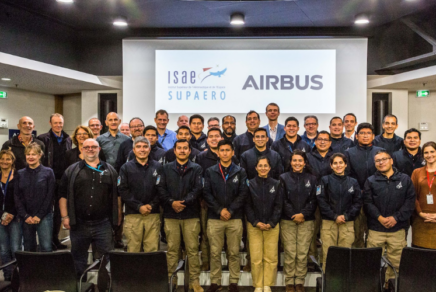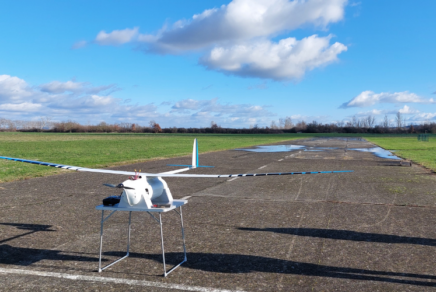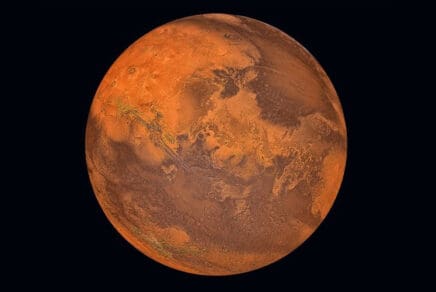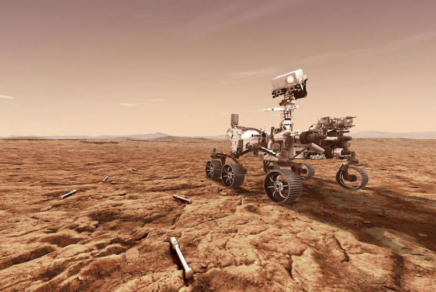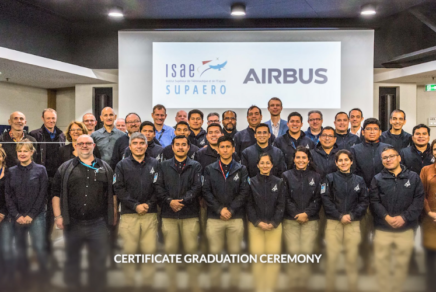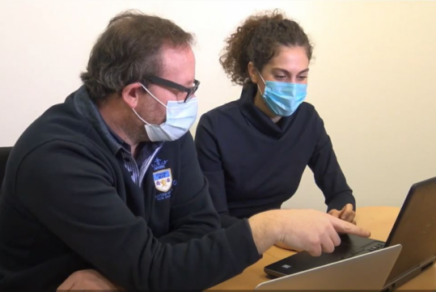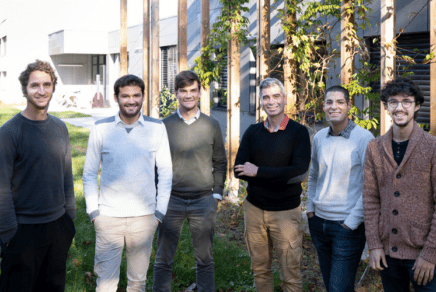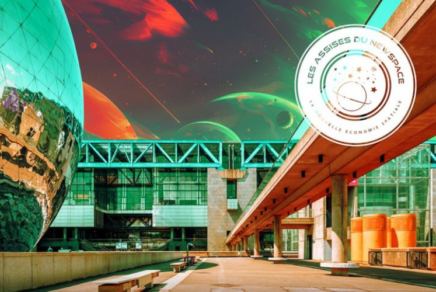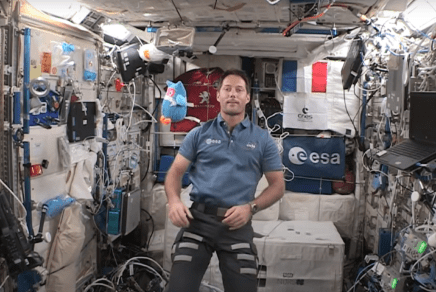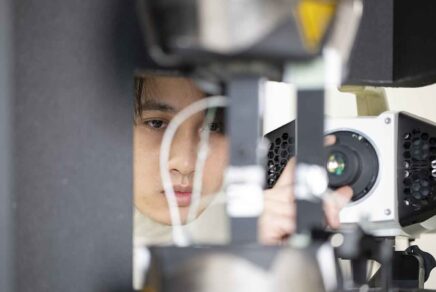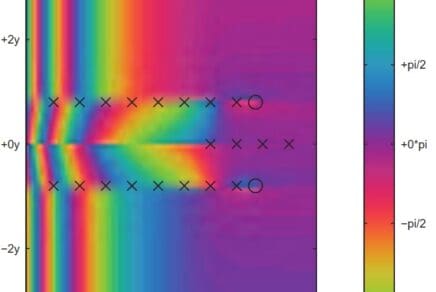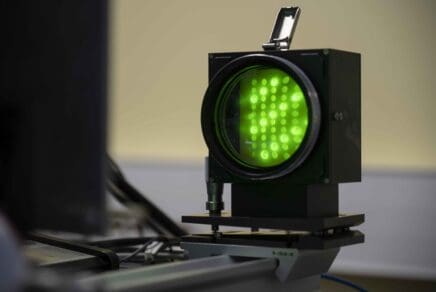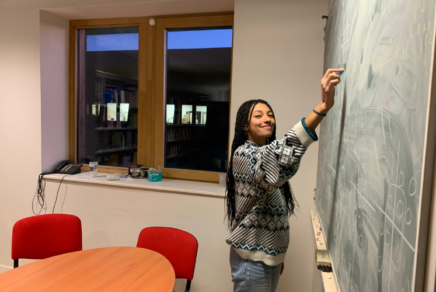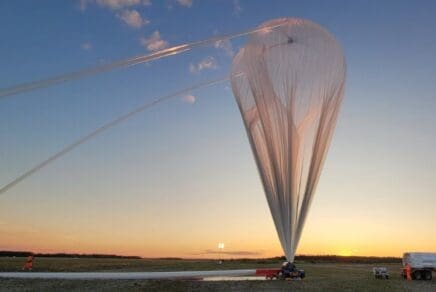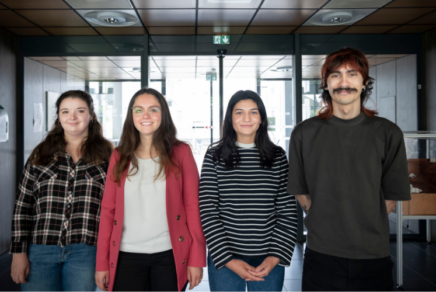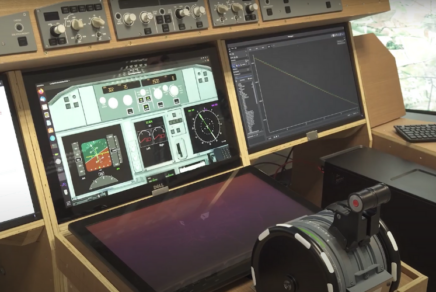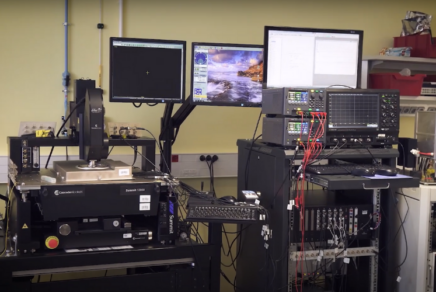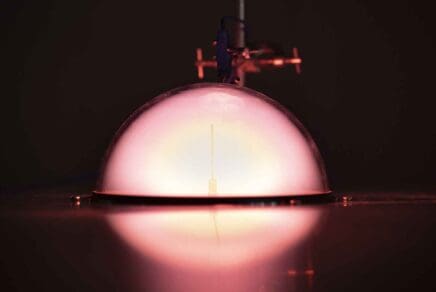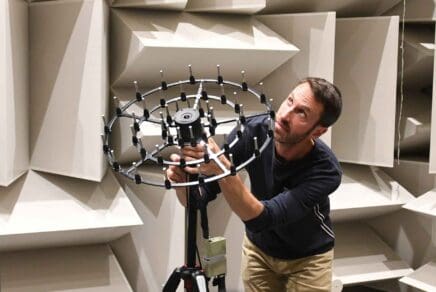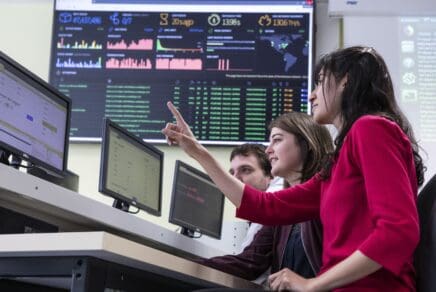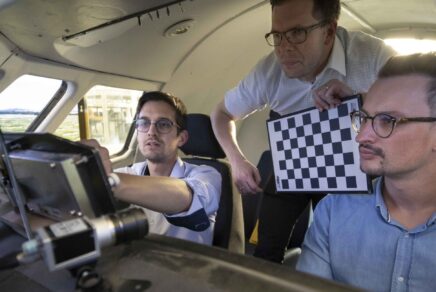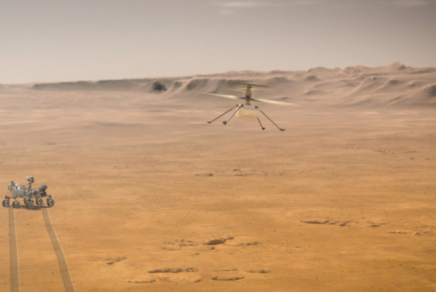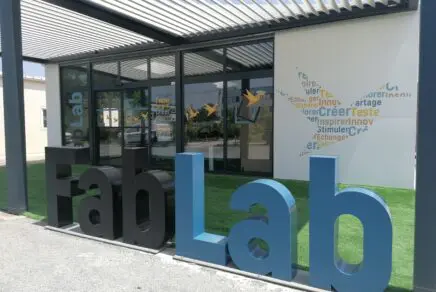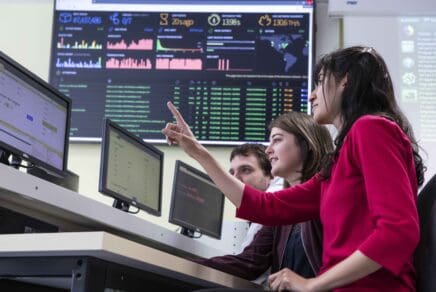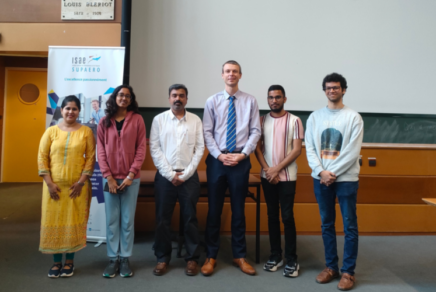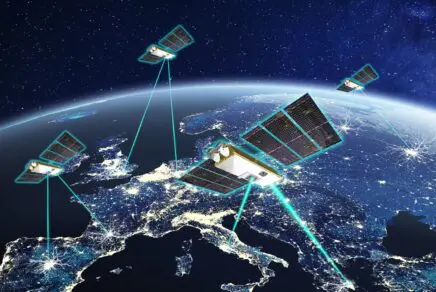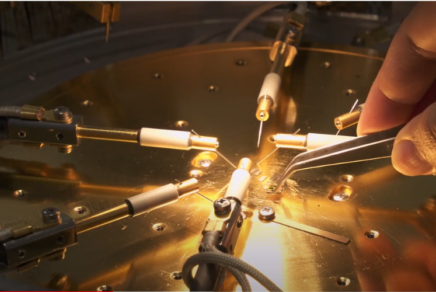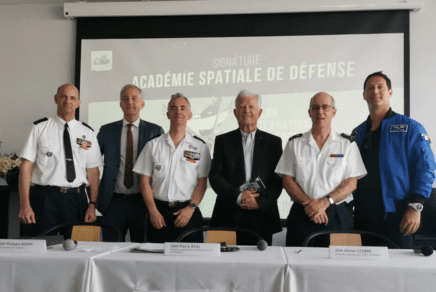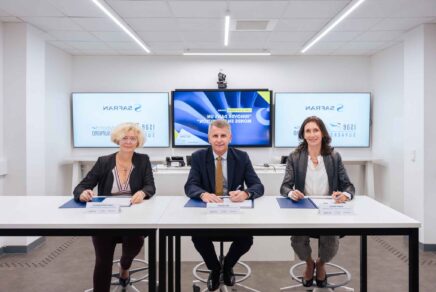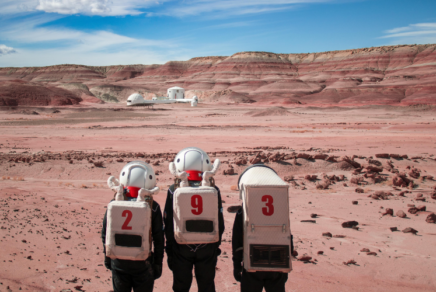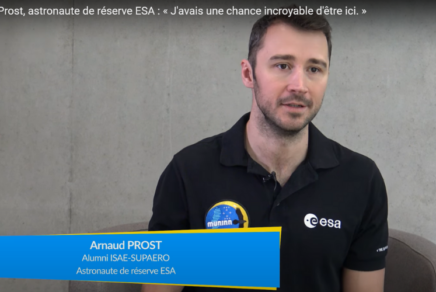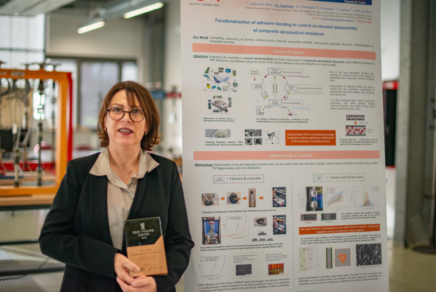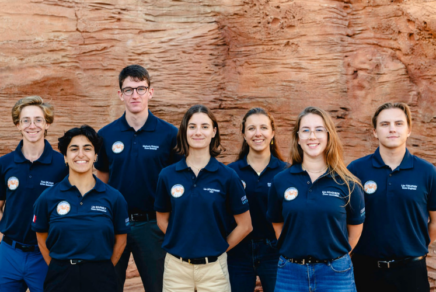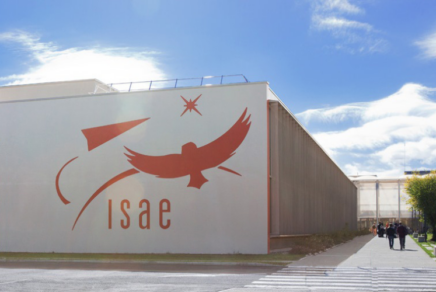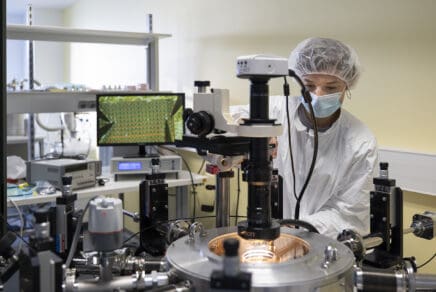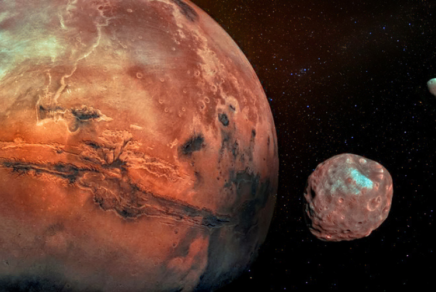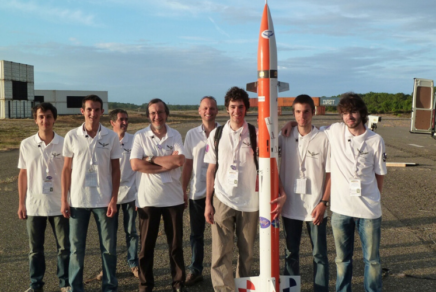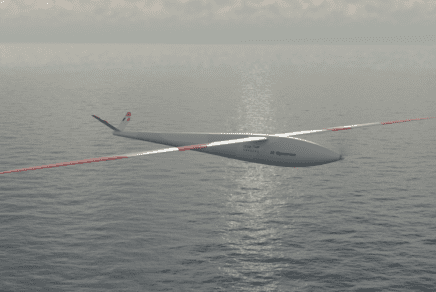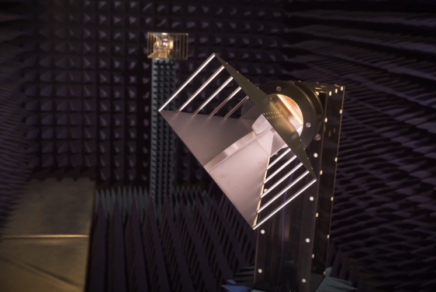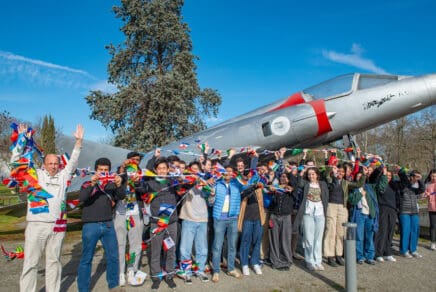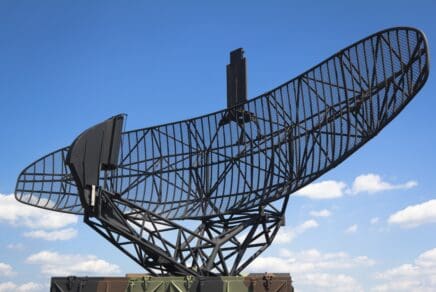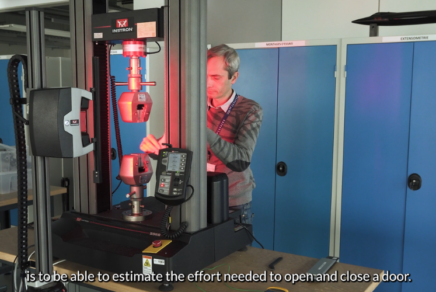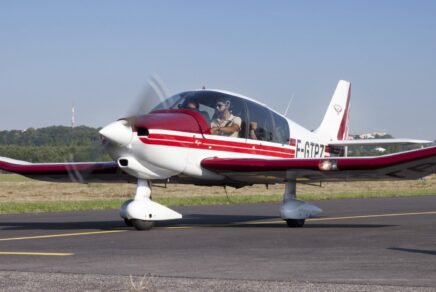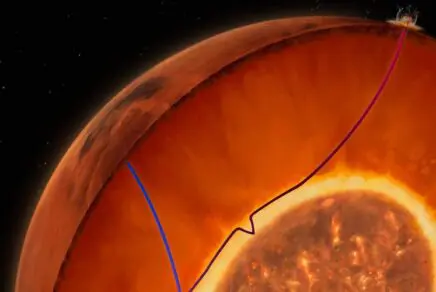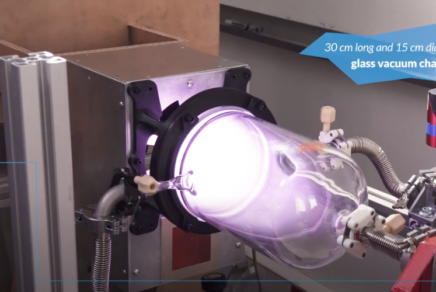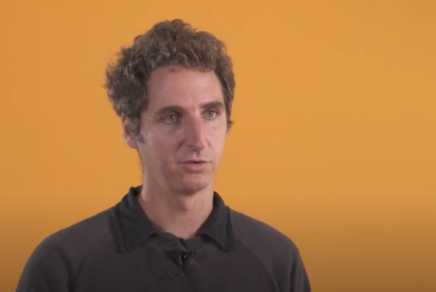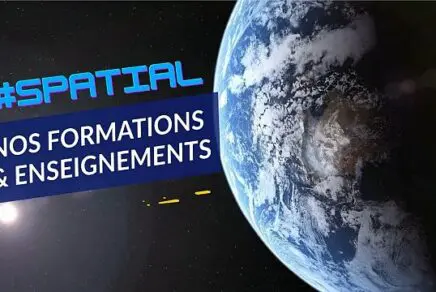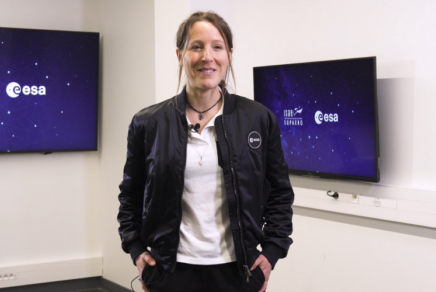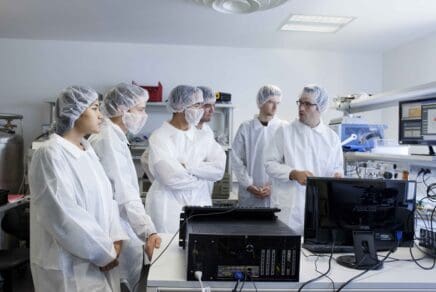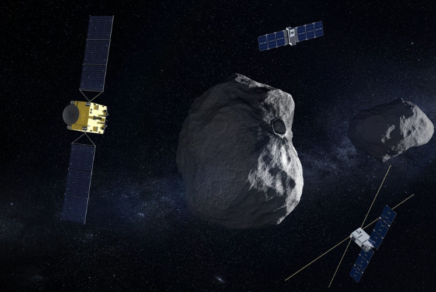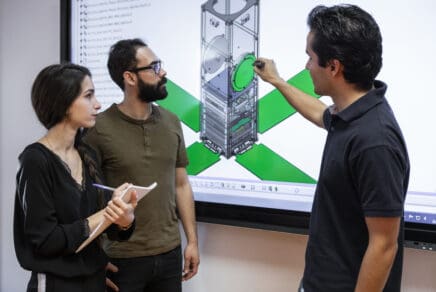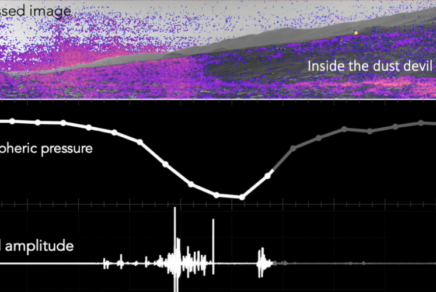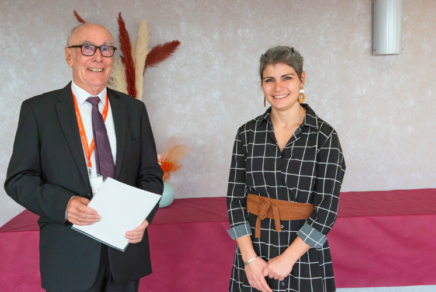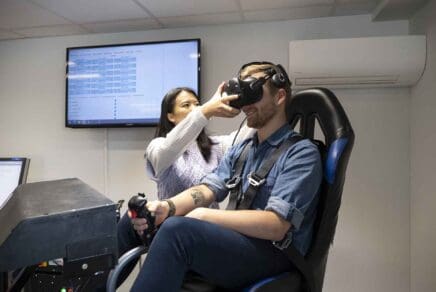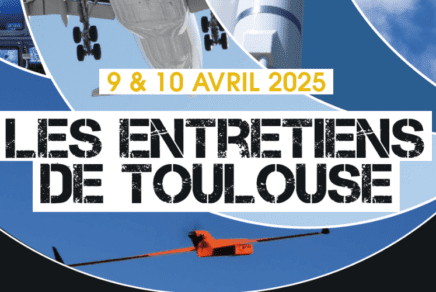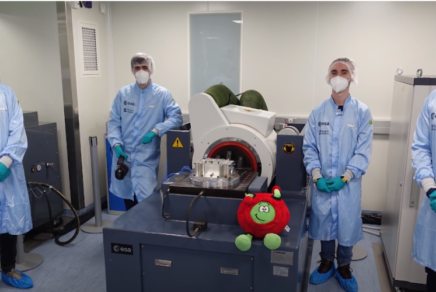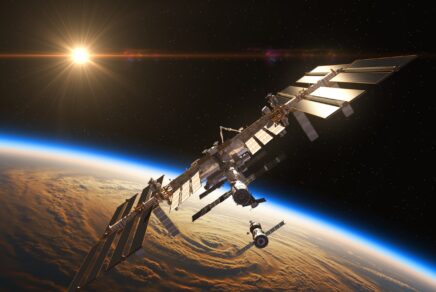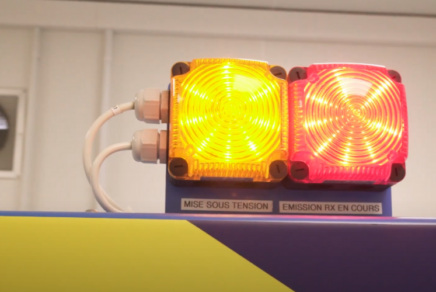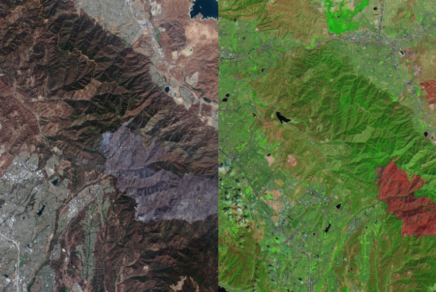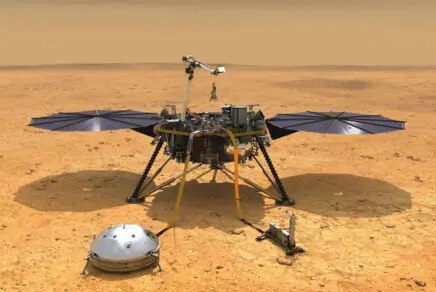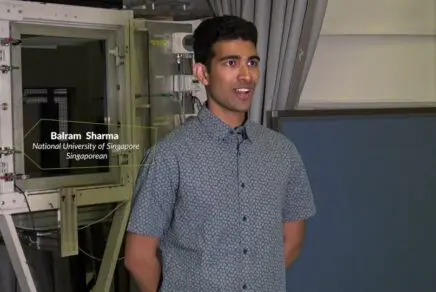Le groupe « Systèmes Spatiaux pour la Planétologie et ses Applications » (SSPA) se concentre sur un axe de recherche principal : le développement de missions et des technologies associées pour l’exploration géophysique du système solaire.
Sur le même sujet
Pages
Groupe scientifique « Conception et Analyse des Systèmes Critiques » CASCLe groupe « Conception et Analyse des Systèmes Critiques » (CASC) s’intéresse aux méthodes, processus et outils supports à l’Ingénierie Système et l’Ingénierie des Systèmes.
Chercheur
DISC
Doctorant
Actualités
3 questions à… Loïc Jecker, membre du S-Cube de 2011 à 2013Rencontre avec Loïc Jecker, membre du S-Cube - SUPAERO Space Section - club de fusées expérimentales de l'ISAE-SUPAERO, de 2011 à 2013.
Club étudiant
Espace
Vie étudiante
Actualités
3 questions à… Marie-Bertille Mosnier, membre du S-Cube de 2018 à 2022Rencontre avec Marie-Bertille Mosnier,membre du S-Cube - SUPAERO Space Section - club de fusées expérimentales de l'ISAE-SUPAERO, de 2018 à 2022.
Club étudiant
Espace
Vie étudiante
Pages
Le DMSM à l'Institut Clément Ader (ICA)L’Institut Clément Ader (UMR CNRS 5312) est le laboratoire de recherche en mécanique du solide de Toulouse et de sa région, sous l’égide du CNRS. Il fédère les équipes de recherche de quatre établissements et trois ministères : l’Université Toulouse III Paul Sabatier (Éducation Nationale), l’INSA (Éducation Nationale), l’ISAE-SUPAERO (Défense) et l’École des Mines d’Albi (Industrie). Ces établissements sont situés sur trois villes de Midi-Pyrénées, Toulouse, Albi et Tarbes.
Chercheur
DMSM
Doctorant
Actualités
OPEN SCIENCE ISAE-SUPAERO : la science de l’ISAE-SUPAERO à ciel ouvert !L’ISAE-SUPAERO poursuit sa contribution au mouvement de la science ouverte et crée sa nouvelle plateforme d’archives ouvertes nommée OPEN SCIENCE ISAE-SUPAERO. Elle permet à tous d’accéder à nos thèses, publications, instruments scientifiques et plateformes technologiques.
Publication scientifique
Science
Thèse
Actualités
SILOE, un projet expérimental en tour de chute sélectionné par l’ESA et une bourse ESPACE pour Alexia DuchêneLe projet expérimental SILOE en tour de chute a pour objectif d’étudier la cohésion des surfaces planétaires. Ce projet étudiant est soutenu par l’ESA dans le cadre de son programme européen « Academy Experiments ». Alexia Duchêne, « project leader » de SILOE, s’est vue attribuer une bourse d’excellence de la Fondation des Ailes de France.
DEOS
Espace
Actualités
Airbus Defence and Space et l’ISAE-SUPAERO forment des membres de l’agence spatiale péruvienneVingt ingénieurs de l’agence spatiale péruvienne ont suivi à Toulouse une formation conçue conjointement par l’ISAE-SUPAERO et Airbus Defence and Space, afin de développer leurs compétences dans le domaine des systèmes spatiaux et des missions spatiales.
DCAS
Espace
Programme court
Vidéos
Essai en vol du drone Mermoz - 20 janvier 2023Courant janvier, le premier démonstrateur « Drone Mermoz » embarquant de l’hydrogène gazeux a effectué avec succès son premier vol radiocommandé sur la piste du club d’aéromodélisme de Muret en région toulousaine (31). Le démonstrateur, de 4 mètres d’envergure, présente un design inspiré des albatros qui exploitent les turbulences atmosphériques pour voler très longtemps en limitant leurs efforts. La route sera longue pour le « Défi Mermoz » qui ambitionne de réaliser, à l’horizon 2025, une traversée de l’Atlantique Sud sur la ligne mythique de l’Aéropostale reliant Dakar (Sénégal) à Natal (Brésil) ouverte par Jean Mermoz.
Aéronautique
Chercheur
DAEP
Pages
Intégrité scientifique et de rechercheL’ISAE-SUPAERO est l’un des établissements signataires de la Charte nationale de déontologie des métiers de la recherche, adoptée en janvier 2015 par la Conférence des Présidents d’Université (CPU) et l’ensemble des organismes nationaux de recherche, et intégrée au règlement intérieur de l’Institut.
Chercheur
DAEP
DCAS
Actualités
À l’écoute du passé martien : l’ISAE-SUPAERO au cœur de la mission ExoMarsLa mission ExoMars Rosalind Franklin de l’ESA dédiée à l’exploration de Mars embarquera un instrument unique d’enregistrement du son et des données atmosphériques de la planète Mars. L’Institut a été sélectionné par l’ESA et le CNES pour cette collaboration scientifique d’envergure.
Chercheur
DEOS
Enseignant-chercheur
Actualités
Rencontre avec Yves Gourinat, élu membre titulaire à l’Académie de l’Air et de l’EspaceYves Gourinat est professeur de physique des structures au sein du département Mécanique des Structures et Matériaux (DMSM) à l’ISAE-SUPAERO. Déjà membre correspondant depuis 2019, il vient d’être élu membre titulaire de l’Académie de l’Air et de l’Espace.
Aéronautique
Disctinction
Enseignant-chercheur
Actualités
Capter l’activité sismique d’un astéroïde : notre rendez-vous sur ApophisLes contributions scientifiques des chercheurs de l’ISAE-SUPAERO se poursuivent pour la conception du premier sismomètre qui sera déployé sur un astéroïde par la mission Ramses de l’ESA.
DEOS
Espace
Recherche
Vidéos
Perseverance recueille les premiers sons martiens : explications par les Dr. Naomi Murdoch & Dr Alexander StottDr Naomi Murdoch, chercheuse en instrumentation spatiale et science planétaire et le Dr Alexander Stott, post-doctorant, nous en disent plus sur les caractéristiques physiques de l’atmosphère de Mars, en particulier sur la vitesse du son et son atténuation. Ces analyses ont fait l’objet d’une publication dans la revue Nature le 1er avril 2022 par une équipe internationale dirigée par un enseignant-chercheur de l’Université Toulouse III – Paul Sabatier et regroupant des scientifiques du CNRS et de l’ISAE-SUPAERO.
Chercheur
DEOS
Espace
Vidéos
L’ISAE-SUPAERO et Airbus Defence and Space ont organisé une formation internationale sur les systèmes spatiauxVingt ingénieurs de l’agence spatiale péruvienne CONIDA (Comisión Nacional de Investigación y Desarrollo Aeroespacial) ont suivi à Toulouse une formation conçue conjointement par l’ISAE-SUPAERO et Airbus Defence and Space ! L’objectif ? Développer leurs compétences en matière de systèmes spatiaux et de missions spatiales. L’ensemble du programme a été placé sous la responsabilité académique d’AnnaFederica Urbano, enseignante-chercheuse en systèmes spatiaux et lanceurs à l’ISAE-SUPAERO. Les ingénieurs ont participé à un projet de conception préliminaire de satellite. À l’issue de ces cinq semaines, ils ont tous obtenu le Certificat d’Études Avancées délivré par l’ISAE-SUPAERO. Pour l’ISAE-SUPAERO et Airbus Defence and Space, cette expérience ouvre des perspectives pour de futures collaborations dans des formations de ce type pour des clients et des partenaires industriels et institutionnels internationaux. Plus d’informations ici : https://www.isae-supaero.fr/fr/actualites/airbus-defence-and-space-et-l-isae-supaero-forment-des-membres-de-l-agence/
Cursus
Espace
Actualités
Ariane 6 : à l’ISAE-SUPAERO, des chercheurs travaillent déjà à l’aprèsLe lanceur européen Ariane 6 intègre des innovations technologiques majeures comme le moteur Vinci, capable de se rallumer dans l’espace. À l’ISAE-SUPAERO, des chercheurs se confrontent aux défis que représentent les moteurs de fusée de demain.
Espace
Actualités
Des chercheurs de l’ISAE-SUPAERO travaillent à une présence durable de l’Homme sur la LuneAlors qu’était fêté l’année dernière le 50ᵉ anniversaire de la mission Apollo 17, dernier voyage habité vers la Lune, le développement du “New Space” a permis de relancer l’attrait du secteur spatial pour l’exploration lunaire.
DCAS
Espace
Vidéos
Découvrez le portrait d’Anthéa COMELLINI doctorante à l’ISAE-SUPAEROAnthéa a mené sa thèse au sein du Département Ingénierie des Systèmes Complexes (DISC). Son intitulé est : « Rendez-vous autonomes basés vision avec cibles non coopératives ». Anthéa est rattachée à l’école doctorale AA - Aéronautique Astronautique. Sa thèse réalisée en collaboration avec Thales Alenia Space fait partie du dispositif CIFRE* L’ISAE-SUPAERO accueille ses doctorants au sein de six équipes à l’ISAE-SUPAERO, ONERA et à l’institut Clément Ader, couvrant un large spectre de disciplines scientifiques liées au domaine aéronautique et espace : aérodynamique et propulsion, structures et matériaux, systèmes embarqués, réseaux et télécommunications, contrôle et conduite des systèmes, facteurs humains, électronique, signal. L’ISAE-SUPAERO offre un programme riche et diversifié de formation doctorale, conduisant au doctorat, diplôme de plus haut niveau délivré par l’institut, et reconnu au niveau international. *Depuis 1981, le dispositif CIFRE - Conventions Industrielles de Formation par la REcherche - permet à l’entreprise de bénéficier d’une aide financière pour recruter un jeune doctorant dont les travaux de recherche, encadrés par un laboratoire public de recherche, conduiront à la soutenance d’une thèse en trois ans. Les CIFRE sont intégralement financées par le ministère de l’Enseignement supérieur et de la Recherche qui en a confié la mise en œuvre à l’ANRT (Association Nationale de la Recherche et de la Technologie).
Doctorat
Thèse
Actualités
L’ISAE-SUPAERO publie un référentiel Aviation et ClimatLe 18 octobre dernier, l’ISAE-SUPAERO a dévoilé son référentiel « Aviation et Climat » pour nourrir le débat de l’impact de l’aviation sur le réchauffement climatique. Ce document de référence synthétise les dernières publications scientifiques internationales, et fournit les éléments concrets nécessaires à la compréhension des enjeux de la décarbonation du transport aérien. Un rapport scientifique inédit pour permettre la construction d’opinions éclairées sur les enjeux et pistes d’innovation aviation et climat !
Développement Durable
Enseignant-chercheur
Événements
Les Assises du New Space 2025 : échanges & débats autour du NewSpace !L’édition 2025 des Assises du New Space se tiendra cette année les 8-9 juillet 2025 au Centre des congrès de la Villette - Cité des sciences et de l’industrie à Paris. S’adressant à l’ensemble des acteurs de l’écosystème spatial français, cet événement est une occasion unique d’échanger et de débattre autour du NewSpace et de découvrir les dernières innovations technologiques et opportunités de financement de projets. Les inscriptions sont ouvertes !
Conférence
Espace
Événement
Vidéos
Une surprise venue d’ailleurs... depuis l’ISS...?Allo la terre ? Thomas Pesquet à l’appareil ! Thomas Pesquet, astronaute français et célèbre alumni de l’ISAE-SUPAERO (promotion 2001) est actuellement dans l’ISS dans le cadre de sa nouvelle mission Alpha. Il a tenu à adresser à nos étudiants un chouette message personnalisé depuis le laboratoire européen Colombus...
Alumni
Espace
Ouverture sociale
Vidéos
Professeurs invités à l'ISAE-SUPAERO : DAN SCHEERESL’ISAE-SUPAERO est un centre de formation par la recherche, de formation à la recherche et à l’innovation, pilotant ses activités pour obtenir un bon équilibre entre excellence scientifique, visibilité académique et proximité des finalités industrielles Ses activités de recherche ont contribué à faire de l’école un leader international, non seulement en termes de programme d’ingénierie aérospatiale, mais aussi de formations « post-graduate », notamment Master of Science (MSc), Mastère Spécialisé® et doctorat (PhD) dans le domaine de l’ingénierie aérospatiale. C’est pourquoi de nombreux acteurs internationaux de la recherche rendent visite à leurs homologues de l’ISAE-SUPAERO. Nous avons rencontré Dan Sheeres, professeur émérite de l’université du Colorado et titulaire de la chaire A. Richard Seebass au département des sciences de l’ingénierie aérospatiale Ann and H.J. Smead de l’université du Colorado Boulder. Les recherches de Dan Scheeres portent sur l’astrodynamique et la navigation des engins spatiaux, les sciences planétaires et la mécanique céleste. dans ces domaines. L’astéroïde 8887 est nommé "Scheeres" en reconnaissance de ses contributions à la compréhension scientifique de l’environnement dynamique des astéroïdes. Pendant son séjour à l’ISAE-SUPAERO, le professeur Scheeres et l’équipe "Systèmes spatiaux pour les applications planétaires" ont collaboré à l’analyse des données DART et au développement de concepts permettant de sonder la structure interne des astéroïdes lors de futures missions spatiales. En outre, Dan Scheeres et l’ISAE-SUPAERO ont publié conjointement plusieurs articles dans "Nature" sur les astéroïdes et la mission DART. https://www.nature.com/articles/s41586-023-05810-5 https://www.nature.com/articles/s41586-023-05878-z En savoir plus sur Dan Scheeres : https://www.colorado.edu/aerospace/daniel-scheeres En savoir plus sur DART : https://www.isae-supaero.fr/en/videos/the-dart-mission-reached-its-target-explanations-from-dr-naomi-murdoch/
Chercheur
DEOS
Espace
Pages
Groupe scientifique « Apprentissage, Décision, Optimisation » (ADO)Le groupe de recherche « Apprentissage, Décision, Optimisation » (ADO) s’intéresse à l’aide à la décision pour des applications allant des systèmes autonomes (planification, apprentissage, supervision) aux systèmes industriels (conception, développement, opérations, etc.).
Chercheur
DISC
Doctorant
Pages
Département Mécanique des Structures et MatériauxLe Département Mécanique des Structures et Matériaux a pour vocation d’organiser et de superviser l’ensemble des activités d’enseignement de la mécanique du solide déformable pour les formations de l’ISAE-SUPAERO, en synergie avec les activités recherche amont et appliquées sur les matériaux et les structures aéronautiques. Cette interaction forte entre enseignement et recherche est le socle de l’organisation de notre département.
Chercheur
DMSM
Doctorat
Pages
Groupe scientifique « Mathématiques Appliquées » MALe groupe de recherche de Mathématiques Appliquées (MA) s’intéresse à des thématiques variées : processus stochastiques (notamment les processus de Markov), optimisation numérique (notamment multidisciplinaire) et calcul parallèle, stabilisation, contrôle et résolution numérique des équations aux dérivées partielles, et enfin l’ingénierie financière.
Chercheur
DISC
Doctorant
Pages
Validation des Acquis de l'Expérience (VAE)La Validation des Acquis de l’Expérience (VAE) est un droit individuel inscrit dans le Code du travail et dans le Code de l’éducation. Elle permet d’obtenir tout - ou partie - d’une certification professionnelle (Diplôme, Titre à finalité professionnelle, Certificat de Qualification Professionnelle) en faisant valoir les acquis d’expériences professionnelles, salariées ou non salariées, et/ou bénévoles, et/ou volontaires. Ce dispositif peut être mobilisé si le candidat souhaite une reconnaissance personnelle ou plus généralement au service d’un projet professionnel qu’il souhaite concrétiser.
Aéronautique
Aérospatial
Certificats d'études spécialisées
Actualités
Un protocole choisi pour sécuriser les communications face aux ordinateurs quantiquesLe NIST (National Institute of Standards and Technology), organisme de normalisation américain, a sélectionné HQC (Hamming Quasi-Cyclic), un protocole développé par des chercheurs de l’ISAE-SUPAERO, de l’ENAC et de l’Université de Limoges, pour faire face aux futures menaces des ordinateurs quantiques. Ce protocole devrait permettre d’assurer la sécurité des échanges numériques pendant des décennies.
Chercheur
DISC
Enseignant-chercheur
Pages
Département Électronique, Optronique et SignalA l'ISAE SUPAERO, le Département d’Électronique, d’Optronique et de Traitement du Signal (DEOS) étudie, conçoit et réalise des instruments scientifiques pour des applications liées à l’aéronautiques, au spatial et à la défense, avec une orientation marquée vers les systèmes avancés et les missions d’exploration planétaire.
DEOS
Actualités
L’ISAE-SUPAERO annonce un nouveau partenariat avec l’ESA Academy pour soutenir ses futurs étudiants du Master in Aerospace EngineeringL’ISAE-SUPAERO est ravi d’annoncer une nouvelle collaboration stratégique avec l’ESA Academy, visant à fournir un soutien financier aux futurs étudiants du programme de Master in Aerospace Engineering (MAE) à partir de la rentrée de septembre 2025.
Aérospatial
Bourse
Espace
Actualités
Zoom sur... la physique quantique à l’ISAE-SUPAERO : un parcours étudiantL’ISAE-SUPAERO intègre de façon ininterrompue depuis 1980 la physique quantique dans ses activités de formation et de recherche et propose depuis deux décennies des enseignements liés à la seconde révolution quantique.
DEOS
Doctorant
Ingénieur généraliste
Actualités
Percer les secrets des séismes à l’aide de ballons stratosphériquesUne équipe de chercheurs du DEOS a franchi une étape significative dans l’utilisation des données infrasonores captées par des ballons stratosphériques pour la compréhension des signaux sismiques. Cette avancée, publiée dans Earth Planets Space*, ouvre de nouvelles perspectives pour l’étude des séismes, tant sur la Terre que sur d’autres planètes.
Chercheur
DEOS
Science
Actualités
DART : des étudiants de l’ISAE-SUPAERO publient de nouveaux résultats scientifiques dans la revue Nature CommunicationsNaomi Murdoch, chercheuse en planétologie à l’ISAE-SUPAERO, participe activement aux analyses scientifiques et à l’interprétation des données de la mission DART de la NASA.
DEOS
Espace
Vidéos
Sylvestre Maurice présente la mallette pédagogique SUPERCAM / Exploration MartienneLe projet de mallettes pédagogiques "SUPERCAM - exploration martienne" a été initié par 5 partenaires : l'ISAE-SUPAERO, l’Académie de Toulouse, le CNRS, le CNES et la Cité de l'espace. Sous l’impulsion et l’encadrement de l’astrophysicien Sylvestre Maurice, des étudiants de première année de l’ISAE-SUPAERO ont réalisé cet outil #éducatif de sensibilisation à l'exploration spatiale en classe, de la sixième à la Terminale. Cette mallette est mise à disposition des enseignants de collèges et lycées et permet, au travers de différentes adaptations, de proposer des séquences pédagogiques en lien avec cette thématique.
Chercheur
Égalité des chances
Espace
Actualités
Prix du meilleur article scientifique décerné par l’American Institute of Aeronautics and Astronautics 2024 Multidisciplinary Design OptimizationSix chercheurs de l’ISAE-SUPAERO, de l’EPFL et de l’Université des sciences et technologies de Hong Kong se sont vu décerner le prix du meilleur article scientifique par l’AIAA pour leur article : “DeepGeo : Deep Geometric Mapping for Automated and Effective Parameterization in Aerodynamic Shape Optimization”.
Chercheur
Prix
Publication scientifique
Vidéos
Découvrez... les robots terrestres mobiles de l’ISAE-SUPAEROL'ISAE-SUPAERO - en tant que centre de formation par la recherche, de formation à la recherche et d’innovation - dispose de nombreux équipements de recherche utilisés au sein de ses 6 départements de recherche. Aujourd’hui, nous vous présentons les robots terrestres mobiles ! Que ce soit les robots, les avions, les voitures ou même les téléphones, toutes ces technologies sont équipées de systèmes de perception. Ces sources d’information permettent, selon l’application, de percevoir l’environnement dans lequel un système évolue et de mesurer également ses propres caractéristiques comme sa vitesse ou son accélération. Cette multitude de données doit alors être utilisée, croisée et interprétée au sein du système de navigation pour obtenir le positionnement du véhicule, mais par ailleurs, dans le cas des applications de cartographie, celui des objets qui l’entourent. Au sein de l’équipe NAVIRRES du DEOS, les chercheurs s’intéressent aux systèmes de navigation et à leur mise en application dans des environnements complexes où les informations des capteurs peuvent être dégradées, erronées ou indisponibles. Ainsi, des plates-formes d’acquisition mobiles sont développées. Elles sont équipées de caméras, lidars, récepteurs GNSS (Global Navigation Satellite System), radars et centrales à inertie, dans le but d’obtenir le système de navigation le plus performant selon l’application visée. Un des thèmes de recherche de l’équipe porte sur l’analyse des dégradations de l’information issue des capteurs qui permet de développer de nouveaux algorithmes robustes et adaptatifs, qui pallient aux contraintes environnementales. L’objectif est de rendre les systèmes de navigation plus précis et plus sûrs, pour des applications critiques nécessitant de fortes contraintes de fiabilité, comme pour les voitures autonomes ou la robotique d’exploration par exemple.
DEOS
Vidéos
Découvrez... les capteurs d’image de type CMOS de l’ISAE-SUPAEROL'ISAE-SUPAERO - en tant que centre de formation par la recherche, de formation à la recherche et d’innovation - dispose de nombreux équipements de recherche utilisés au sein de ses 6 départements de recherche. Aujourd’hui, nous vous présentons les capteurs d’image de type CMOS ! Les capteurs d’image de type CMOS occupent une place de plus en plus importante dans notre vie de tous les jours. Ainsi, notre équipe de l’ISAE-SUPAERO développe depuis plusieurs années des capteurs d’image CMOS avec de nombreux acteurs du domaine, et innove en proposant des architectures nouvelles et des conditions d’utilisation nécessitant des études portant sur des composants élémentaires, mais également sur des structures plus complexes. Des mesures sont alors opérées sur des transistors, des diodes avec l’aide du testeur sous-pointes et d’un analyseur paramétrique autorisant des mesures de courant très basses (10 aA). De même, des structures simples contenant des pixels innovants peuvent être opérées avec le testeur utilisant des cartes à pointes couplées à un générateur de mots spécialement conçu pour les capteurs d’image. Toutes ces études permettent de mieux comprendre la physique de la photodétection, mais également de constituer des modèles pour nos simulateurs. Elles servent également à suivre les procédés de fabrication au cours des différentes réalisations.
DEOS
Pages
Groupe scientifique « Photonique Antenne Microondes PlasmA » (PAMPA)Le groupe « Photonique Antenne Microondes PlasmA » (PAMPA) s’intéresse à l’électromagnétisme dans les domaines des microondes et de la photonique ainsi qu’aux interactions ondes plasma.
Chercheur
DEOS
Doctorant
Actualités
Campus au féminin : sensibiliser les jeunes filles aux carrières scientifiquesJeudi 6 février et jeudi 13 mars 2025, L’ISAE-SUPAERO a accueilli près de 250 collégiennes et lycéennes des établissements de Toulouse et de la région Occitanie pour la journée Campus au féminin. Cet événement a pour objectif la sensibilisation des jeunes femmes aux métiers d’ingénieures à travers différents ateliers. Portée par le programme d’ouverture sociale de l’Institut OSE l’ISAE-SUPAERO et le club étudiant ISAElles, cette journée traduit l’engagement de l’ISAE-SUPAERO et de sa Fondation en faveur de l’égalité des chances.
Carrière
Échange
Égalité des chances
Pages
Département Aérodynamique, Energétique et PropulsionÀ l’ISAE SUPAERO, le département Aérodynamique Énergétique et Propulsion : c’est 62 personnes, 30 projets de recherche dont 5 à échelle européenne, un parc exceptionnel de moyens d’essais à vocation pédagogique et de recherche, trois groupes de recherche contribuant à une stratégie de croissance tournée vers 4 thèmes aux enjeux scientifiques et sociaux-économiques d’actualité en s’appuyant sur 2 projets structurants : la soufflerie SAA et le code de simulation aux grandes échelles IC3.
Chercheur
DAEP
Doctorat
Pages
Notre annuaireAnnuaire
Enseignant-chercheur
Témoignages
Témoignage de Baptiste Sigal, étudiant (promotion) 2025 du Mastère Spécialisé® TAS ASTROAérospatial
Espace
Mastère Spécialisé®
Actualités
HACKATHON Sciences Des Données : l’IA en action !Du 24 au 26 février prochains, quarante-cinq étudiants exploreront trois sujets d’actualité faisant appel à l’Intelligence artificielle (IA) lors d’un hackathon de trois jours. Les équipes d’étudiants engagées tenteront de relever les défis posés par trois partenaires industriels sur les thèmes de l’environnement, l’industrialisation et la technologie de numérisation. L’ISAE-SUPAERO confirme son engagement dans la formation aux sciences des données et à l’intelligence artificielle à travers son parcours Sciences de la Décision et des Données (SDD).
Chercheur
Hackathon
IA
Témoignages
Témoignage d’Axel Coulon, étudiant (promotion 2024) du Mastère Spécialisé® TAS ASTRODepuis mai, Axel Coulon est en stage au fameux JPL de la NASA, à Los Angeles. Il y travaille à la détection de sites d’atterrissage d’hélicoptères sur Mars. Étudiant du MS TAS Astro, il raconte cette incroyable aventure spatiale qui l’a mené de sa Lorraine natale en Californie.
Espace
Mastère Spécialisé®
Témoignage
Pages
Nos certificats d'études spécialiséesNos certificats d’études spécialisées s’adressent à des professionnels. Ils permettent de développer des compétences et une expertise dans les domaines du digital, de l’aéronautique, du spatial, du management de projets de l’ingénierie système et de l’intelligence artificielle.
Aéronautique
Aérospatial
Certificats d'études spécialisées
Vidéos
Mallettes Pédagogiques SUPERCAM / Exploration martienne : Les étudiants aux manettes des mallettesUn projet mené en partenariat avec l’ISAE-SUPAERO et sa cordée de réussite OSE l’ISAE-SUPAERO, le CNES, la Cité de l’Espace, l’Académie de Toulouse et le CNRS.
Égalité des chances
Espace
Ouverture sociale
Vidéos
L’INSTRUMENT FRANÇAIS SUPERCAM ENREGISTRE LE SON DU 4èME VOL D’INGENUITYSitué à 80 mètres du rover au moment de son décollage, le petit hélicoptère s’est élevé à 5 mètres au-dessus du sol avant de parcourir une distance de 133 mètres pour ensuite revenir atterrir à l’endroit d’où il avait décollé. Le microphone scientifique de SuperCam, développé par l’ISAE-SUPAERO, a enregistré le son émis par la rotation des pales du drone martien au cours de son vol. Ce son possède une fréquence caractéristique de 84 Hz ; elle équivaut au « mi » grave d’un piano ou à la voix de basse d’un être humain. « C’est une grande surprise pour toute l’équipe scientifique ! » affirme Naomi Murdoch, chercheuse à l’ISAE-SUPAERO qui étudie les données du micro. « Les tests effectués dans un simulateur d’atmosphère martienne pour concevoir cet instrument et nos théories de la propagation du son nous indiquaient que le micro capterait très difficilement les sons de l’hélicoptère. En effet, l’atmosphère de Mars, très peu dense, atténue fortement la transmission des sons. Nous devions avoir un peu de chance pour enregistrer l’hélicoptère à une telle distance. Nous sommes très satisfaits d’avoir réussi à obtenir cet enregistrement qui se révèle une mine d’or pour notre compréhension de l’atmosphère martienne ». Développé conjointement par l’ISAE-SUPAERO et un consortium de laboratoires du CNRS et de ses partenaires, coordonnés par le CNES, le microphone de SuperCam est dérivé d’un modèle grand public adapté pour résister à l’environnement martien. Il poursuit 3 objectifs scientifiques et techniques substantiels de la mission Mars 2020 : L’étude du son associé aux impacts laser sur les roches martiennes pour mieux connaître leurs propriétés mécaniques. L’amélioration de la connaissance des phénomènes atmosphériques (turbulence du vent, tourbillons de poussière, interactions du vent avec le rover, et désormais, avec l’hélicoptère). La compréhension de la signature sonore des différents mouvements du rover (opérations du bras robotique et du mât, roulage sur sol normal ou accidenté, surveillance des pompes, …). Le microphone avait été mis en route pour la première fois quelques heures après l’atterrissage de Perseverance. Il avait alors enregistré les premiers sons martiens provenant de turbulences dans l’atmosphère. Il est utilisé quotidiennement en conjonction avec l’ablation laser des roches pour l’analyse chimique de Mars. À PROPOS DE LA MISSION MARS 2020 : La NASA s’appuie sur le Jet Propulsion Laboratory du Caltech pour le développement de la mission Mars 2020. SuperCam a été développé conjointement par le LANL (Los Alamos National Laboratory, États-Unis) et un consortium de laboratoires rattachés au CNRS, à des universités et établissements de recherche français. Plusieurs universités espagnoles, emmenées par l’université de Valladolid, contribuent aussi à cet instrument. Le CNES est responsable, vis-à-vis de la NASA, de la contribution française à SuperCam. L’instrument est opéré en alternance depuis le LANL et le centre des opérations scientifiques installé au CNES à Toulouse, le FOCSE (French Operations Center for Science and Exploration).
Chercheur
DEOS
Espace
Pages
Nos offres de recrutementAéronautique
Aérospatial
Décarbonation
Actualités
Chaire CASTOR : L’ISAE-SUPAERO et Liebherr-Aerospace Toulouse célèbrent les 1 an de leur partenariatEn janvier 2024, l’ISAE-SUPAERO et Liebherr-Aerospace Toulouse lançaient la chaire CASTOR, une initiative ambitieuse pour améliorer la performance et la flexibilité des turbomachines radiales, des composants clés dans les systèmes de propulsion aéronautique. Un an plus tard, les deux partenaires font un premier bilan de ce projet de recherche commun.
Aéronautique
Chaire
Espace
Pages
Département d’ingénierie des systèmes complexesAu sein de l’ISAE-SUPAERO, le Département d’ingénierie des systèmes complexes (DISC) développe des compétences en mathématiques et informatique pour l’ingénierie aéronautique et spatiale. En enseignement comme en recherche, il s’intéresse aux modèles, méthodes et outils nécessaires pour maîtriser le comportement et les performances de systèmes complexes. Cette complexité peut être induite par le caractère multi-physiques ou multi-échelles des systèmes étudiés, leur comportement dynamique, leur structure distribuée et communicante.
Chercheur
DISC
Doctorat
Vidéos
L’ISAE-SUPAERO et l’Indian Institute of Space Science & Technology travaillent sur des projets étudiants d’exploration spatialeL’ISAE-SUPAERO a reçu la visite du professeur Shine S R de l’Indian Institute of Space Science and Technology (IIST) les 7 et 8 décembre. L’ISAE-SUPAERO a signé en 2020 un accord de co #coopération avec l’Indian Institute of Space Science and Technology et cette visite fut une occasion parfaite pour discuter sur l’approfondissement des collaborations en #formation et #recherche entre nos deux institutions. ISAE-SUPAERO et IIST coopèrent déjà depuis 4 ans dans le cadre des projets académiques collaboratifs franco-indiens, impliquant les étudiants de l’ISAE-SUPAERO et de l’IIST sur des sujets en lien avec les missions d’exploration spatiale et avec la participation des experts du CNES, de l’IRAP et de l’agence spatiale indienne (ISRO) !
Espace
Actualités
Valentin LELOUP, ingénieur système de télécommunications quantiques et optiques : le tandem quantique et spatialValentin Leloup, ingénieur R&D chez Thales conjugue deux domaines de prédilection : la physique quantique et le spatial. Il est diplômé ingénieur ISAE-SUPAERO 2022 et titulaire d’un Master 2 en physique fondamentale et applications.
Actualité
Alumni
Espace
Témoignages
Témoignage d'Yves Gourinat, élu membre titulaire à l’Académie de l’Air et de l’EspaceYves Gourinat est professeur de physique des structures au sein du département Mécanique des Structures et Matériaux (DMSM) à l’ISAE-SUPAERO. Déjà membre correspondant depuis 2019, il vient d’être élu membre titulaire de l’Académie de l’Air et de l’Espace.
DMSM
Enseignant-chercheur
Structures et matériaux
Vidéos
Découvrez... les moyens cryogéniques pour tests électriques de l’ISAE-SUPAEROL'ISAE-SUPAERO - en tant que centre de formation par la recherche, de formation à la recherche et d’innovation - dispose de nombreux équipements de recherche utilisés au sein de ses 6 départements de recherche. Aujourd’hui, nous vous présentons les moyens cryogéniques pour tests électriques ! Le groupe de recherche sur les capteurs d’image (CIMI) de l’ISAE-SUPAERO étudie des capteurs dans le domaine des longueurs d’onde du visible, mais également les capteurs dans des domaines spectrales différents tels que l’infrarouge. La détection de ces plus grandes longueurs d’onde nécessite des matériaux autres que le silicium pour la détection, associé à un circuit de lecture silicium pour le traitement de l’information, le tout fonctionnant à température cryogénique. Dans ce cadre, l’ISAE-SUPAERO a développé des bancs de caractérisation électriques et électro-optiques de circuits microélectroniques à basse température afin d’extraire et de modéliser les comportements et les performances de ceux-ci. Ces bancs de caractérisation permettent d’adresser aussi bien des circuits très simples, de type transistors, que des composants complexes (capteur complet) allant jusqu’à 120 entrées / sorties.
DEOS
Témoignages
Témoignage de Juan-Carlos DOLADO-PEREZ, alumni promotion 2008 du Master's degree in aerospace engineeringAlumni
Espace
Témoignage
Pages
L’Académie Spatiale de DéfensePour conduire et mettre en œuvre l’ambition portée par la Stratégie Spatiale de Défense, la constitution d’une filière d’expertise spatiale de défense dotée de parcours de formation attractifs constitue un enjeu majeur. À cet égard, l’Académie Spatiale de Défense (ASD) propose les formations disponibles au sein du ministère de Armées et met à profit les synergies entre elles pour fournir une approche personnalisée en matière de formation au spatial.
Défense
Espace
Formation
Actualités
Une bourse exceptionnelle pour un projet novateurNaomi Murdoch, chercheuse en physique et planétologie à l’ISAE-SUPAERO, vient d’obtenir la prestigieuse bourse Consolidator du Conseil Européen de la Recherche (ERC) pour son projet d’étude de corps planétaires baptisé GRAVITE. Ce projet scientifique ambitieux vise à concevoir une machine à gravité variable qui permettra de simuler et d’étudier des sols extraterrestres.
Bourse
DEOS
Espace
Témoignages
Témoignage de Giuseppe Cataldo, alumni promotion 2010 du cursus ingénieur généralisteAlumni
Espace
Témoignage
Pages
Innover dans un monde en transition - SafranLes défis des secteurs aéronautique et spatial (transition énergétique, New Space, digitalisation) entrainent un besoin accru de professionnels en capacité d’innover. Dans ce contexte, Safran, l’ISAE-SUPAERO créent la chaire Innover dans un monde en transition.
Aéronautique
Aérospatial
Chaire
Actualités
Simulation de mission sur Mars : une expérience scientifique, une aventure humaineComme neuf autres équipages de l’ISAE-SUPAERO avant eux, sept étudiants ont pris part cet hiver à une simulation de vie martienne dans le désert de l’Utah, aux États-Unis.
Club étudiant
Espace
Vidéos
Arnaud Prost, astronaute de réserve à l’ESA & alumni ISAE-SUPAERO : « J’avais une chance incroyable d’être ici. »Pilote de chasse et astronaute de réserve à l’Agence spatiale européenne (ESA), Arnaud Prost est revenu ce jeudi 28 mars sur les bancs de son ancienne école pour y rencontrer 200 collégiens et lycéens dans le cadre du programme OSE l’ISAE SUPAERO. L’occasion pour lui d’évoquer les « super souvenirs » de son expérience étudiante à l’ISAE-SUPAERO, son engagement de longue date en faveur du programme d’ouverture sociale étudiante ou encore le dispositif « Aquanautes » qu’il a mis en place avec OSE l’ISAE-SUPAERO. Et de glisser au passage quelques conseils aux jeunes qui rêveraient de marcher dans ses pas : « Ne vous laissez pas convaincre qu’une de ces voies n’est pas faite pour vous ! » Diplômé en 2017 de l’ISAE-SUPAERO, Arnaud Prost figure parmi les sélectionnés de la Classe 2022 des astronautes de l’ESA, aux côtés de Sophie Adenot et Anthea Comellini, toutes deux également alumni de l’école. Ils ont ainsi rejoint d’autres illustres astronautes de l’ESA déjà passés sur les bancs de l’école : Thomas Pesquet, Luca Parmitano et Samantha Cristoforetti. L’ISAE-SUPAERO contribue depuis 1970 par ses activités de formation, de recherche et d’innovation aux avancées de l’ère spatiale. Seul organisme français à dispenser des formations diplômantes (ingénieurs, master, mastères spécialisés, doctorat) couvrant toutes les 22 thématiques spatiales identifiées par le CNES, l’Institut constitue une voie royale vers les carrières spatiales. Pour retrouver le profil complet d’Arnaud Prost : https://www.esa.int/Science_Exploration/Human_and_Robotic_Exploration/Astronauts/A
Alumni
Espace
Ouverture sociale
Actualités
L’équipe de recherche SA-I du DMSM a reçu le prix du meilleur poster lors de la 14ème conférence EASNPlusieurs chercheurs du DMSM ont reçu le prix du meilleur poster lors de la 14ᵉ conférence EASN (European Aeronautic Science Network) dédiée cette année à la thématique « Innovation in Aviation & Sace towards sustainability today & tomorrow » !
Chercheur
Conférence
Prix
Actualités
Sept élèves de l’ISAE-SUPAERO à la conquête de Mars dans le désert de l’UtahPendant quatre semaines, sept élèves-ingénieurs vivront une simulation de vie martienne dans le désert de l’Utah, aux États-Unis. Du 18 février au 16 mars, ils mèneront des expériences en collaboration avec le CNES et plusieurs laboratoires de recherche au sein de la Mars Desert Research Station (MDRS).
Club étudiant
Espace
Actualités
La planète Mars frappée par des météroïdes plus souvent qu’on ne le pensaitDeux chercheurs de l’ISAE-SUPAERO ont participé à de nouvelles découvertes à partir des données du sismomètre envoyé sur Mars lors de la mission InSight, dont l’un des principaux objectifs était de mesurer les secousses sismologiques de la planète rouge.
Espace
Actualités
Félicitations à nos 8 enseignants-chercheurs de l’ISAE-SUPAERO qui font partie des 2% des scientifiques les plus performants !L’université de Stanford a récemment publié une mise à jour de la liste des scientifiques les plus influents dans le monde et dans laquelle figurent 8 enseignants chercheurs de l’ISAE-Supaero.
Classement
Enseignant-chercheur
Pages
Groupe scientifique « Capteurs d’IMages Intégrés » (CIMI)Le groupe « Capteurs d’IMages Intégrés » (CIMI) étudie, développe et caractérise des capteurs d’images à pixels actifs (Capteurs CMOS Image Sensor (CIS)) sur silicium pour le rayonnement visible et l’infrarouge.
Chercheur
DEOS
Doctorant
Pages
Groupe scientifique SysCoLa dynamique scientifique du groupe de recherche « Systèmes Connectés » (SysCo) se focalise principalement sur les problématiques concernant les réseaux dans les domaines d’applications liés à l’aéronautique et à l’espace, c'est-à-dire les communications spatiales, les réseaux embarqués et certains types de systèmes connectés.
Chercheur
DISC
Doctorant
Actualités
MMX, Idefix® et des caméras pour comprendre la lune de MarsÉtudier la formation et l’origine des lunes de Mars et en ramener des échantillons : c’est la mission internationale hors norme, ambitieuse, menée par la JAXA, à laquelle participe l’ISAE-SUPAERO aux côtés du CNES.
Chercheur
DEOS
Espace
Actualités
Rencontre avec Stéphanie Lizy-Destrez, élue à l’Académie de l’Air et de l’EspaceÀ l’ISAE-SUPAERO, Stéphanie Lizy-Destrez dirige le SaCLaB, un laboratoire de recherche sur les systèmes spatiaux du futur. Professeure en ingénierie des systèmes spatiaux, elle vient d’être élue à l’Académie de l’Air et de l’Espace.
Disctinction
Enseignant-chercheur
Espace
Actualités
3 questions à… Ervan Kassarian, membre du S-Cube de 2015 à 2017Rencontre avec Ervan Kassarian, membre du S-Cube - SUPAERO Space Section - club de fusées expérimentales de l'ISAE-SUPAERO, de 2015 à 2017.
Club étudiant
Espace
Vie étudiante
Pages
Nos modules courts qualifiantsIssus des programmes de Mastère Spécialisé® de l’Institut, nos modules courts s’adressent à des professionnels souhaitant développer des compétences spécifiques en Aéronautique, Spatial, Management de Projet, Ingénierie Systèmes ou Digital.
Aéronautique
Aérospatial
Espace
Vidéos
3 questions à Marie Delaroche, étudiante de 3ᵉ année & commandante de bord de l’équipage MDRS 293Depuis le 18 février, sept élèves-ingénieurs de l’ISAE-SUPAERO vivent une simulation de vie martienne et mènent des expériences en collaboration avec le CNES & plusieurs laboratoires de recherche au sein de la Mars Desert Research Station (MDRS) de The Mars Society, dans l’UTAH (USA) ! Pour la deuxième fois, la mission est dirigée par une femme : Marie Delaroche, passionnée d’exploration #spatiale, qui faisait déjà partie de l’équipage 275 parti en 2023. Nous lui avons posé 3 questions pour mieux cerner les enjeux de cette mission et son ressenti en tant que #commandante de bord ! À ses côtés, trois jeunes femmes et trois jeunes hommes en 2ᵉ année d’études d’#ingénieur ont endossé les rôles d’astronome, de scientifique, de botaniste, de journaliste, d’agent de santé et d’ingénieur de bord. Tous sont membres du Mars Club ISAE-SUPAERO, une association étudiante de vulgarisation scientifique centrée sur la planète rouge et les missions dédiées à son exploration et à son étude. Ils expérimentent actuellement AI4U, l’intelligence artificielle qui assiste les astronautes dans leurs tâches quotidiennes (mesures environnementales, reconnaissance vocale, exercices d’urgence). Ils mènent également une expérience de vulgarisation scientifique en collaboration avec des élèves de l’enseignement secondaire. Inspirée du film The Martian, dans lequel un astronaute fait pousser des pommes de terre sur la planète rouge, cette expérience a pour but de comparer la croissance des plantes dans le sol martien à la croissance dans le sol terrestre ! Pour suivre leur aventure, suivez ce petit lien : https://mars.bde-supaero.fr/
Club étudiant
Espace
Témoignage
Actualités
Le projet d’un avion sans pilote, zéro émission pour traverser l’Atlantique SudLe projet Drone Mermoz, initié par une équipe de chercheurs du laboratoire d’aérodynamique de l’ISAE-SUPAERO a pour ambition de participer au développement de technologies de rupture pour l’aviation électrique. Traverser l’Atlantique Sud avec un aéronef d’environ 4 mètres d’envergure sans pilote et à propulsion hydrogène représenterait un premier pas vers le développement d’avions bas-carbone de plus grande taille pour le transport aérien.
Chercheur
Développement Durable
Innovation
Vidéos
Découvrez le portrait de Paolo PANICUCCI doctorant à l’ISAE-SUPAEROPaolo a mené sa thèse au sein du Département Ingénierie des Systèmes Complexes (DISC). Son intitulé est : Navigation basée vision autonome et reconstruction de forme d’un astéroïde inconnu pendant la phase d’approche. Il est rattaché à l’école doctorale AA - Aéronautique Astronautique. L’ISAE-SUPAERO accueille ses doctorants au sein de six équipes à l’ISAE-SUPAERO, ONERA et à l’institut Clément Ader, couvrant un large spectre de disciplines scientifiques liées au domaine aéronautique et espace : aérodynamique et propulsion, structures et matériaux, systèmes embarqués, réseaux et télécommunications, contrôle et conduite des systèmes, facteurs humains, électronique, signal. L’ISAE-SUPAERO offre un programme riche et diversifié de formation doctorale, conduisant au doctorat, diplôme de plus haut niveau délivré par l’institut, et reconnu au niveau international. Lien vers sa thèse : http://www.theses.fr/s253653
Doctorat
Thèse
Pages
Groupe scientifique « Navigation, Radar and Remonte Sensing » (NAVIR²eS)Le groupe « Navigation, Radar and Remonte Sensing » (NAVIR²eS) s’intéresse à l’étude théorique des sources d’information ainsi qu’aux approches d’hybridation dans le cadre d’application de navigation autonome de véhicules.
Chercheur
DEOS
Doctorant
Vidéos
Découvrez... la chambre anéchoïque radio de l’ISAE-SUPAEROLes drones et les nanosatellites trouvent de nombreuses applications dans les secteurs des médias, de l’industrie, de l’agriculture ou encore des télécommunications. Ces deux types de plateformes ont pour contrainte commune d’embarquer des systèmes complexes dans un volume réduit. Un des éléments clés des systèmes de communication embarqués est l’antenne qui doit, elle aussi, être compacte et légère. L’ISAE-SUPAERO, en collaboration avec l’ENAC et la société ANYWAVES, développe actuellement des antennes diélectriques réalisées par impression 3D de céramique répondant aux critères exigeants d’intégration sur drones et nanosatellites. Grâce à la chambre anéchoïque disponible à l’ISAE-SUPAERO, les chercheurs impliqués dans le développement de ces antennes originales peuvent caractériser leurs propriétés en rayonnement avec précision et ainsi valider les nouvelles solutions technologiques proposées.
DCAS
DEOS
Pages
Nos semestres & programmes courtsAéronautique
Aérospatial
Espace
Pages
Groupe scientifique « Communication et théorie de l’InformaTion » (ComIT)Le groupe « Communication et théorie de l’InformaTion » (ComIT) intervient dans les disciplines des communications numériques, du radar, des techniques d’accès aux canaux. Ses domaines applicatifs s’articulent autour des systèmes spatiaux, de l’aviation civile et militaire, des réseaux cellulaires terrestres et de l’Internet des objets (IoT).
Chercheur
DEOS
Doctorant
Pages
Soutien au développement du Groupe ISAE - GIFASLe GIFAS (Groupement des Industries Françaises Aéronautiques et Spatiales) apporte son appui pour le développement d’un enseignement académique et professionnel de haut niveau dans le domaine des systèmes aérospatiaux des 6 grandes écoles qui composent le Groupe ISAE (ISAE-ENSMA, ISAE-SUPMECA, ESTACA, Ecole de l’Air et de l’Espace, ENAC, ISAE-SUPAERO).
Aéronautique
Aérospatial
Chaire
Vidéos
Retour d’expérience : un ingénieur Latecoere dans les laboratoires de l’ISAE-SUPAEROAfin de renforcer les liens entre industrie et recherche, plus de 10 ingénieurs industriels R&D ont été mis à disposition de l’ISAE-SUPAERO dans le cadre du plan France Relance ! Cyril Geneste, ingénieur de recherche chez Latecoere, en fait partie. Avec Miguel Charlotte, professeur associé à l’Institut, il revient sur cette collaboration fructueuse qui a duré deux ans. Leurs travaux, menés dans les laboratoires de l’ISAE-SUPAERO, ont porté sur le comportement des joints de porte des avions, qui assurent l’étanchéité de la cabine. Grâce aux équipements de pointe et à l’expertise académique de l’Institut, Cyril Geneste a notamment pu réaliser des modélisations numériques de joints afin d’en éprouver le comportement. Des élèves de 3ᵉ année du cursus ingénieur ont également été impliqués dans ces travaux.
Aéronautique
Chercheur
Pages
Centre des Opérations Aériennes de LasbordesLe Département Conception et Conduite des véhicules Aéronautiques et Spatiaux (DCAS) intègre le Centre des Opérations Aériennes de Lasbordes (COAL) situé sur un aérodrome à quelques kilomètres du campus de L’ISAE-SUPAERO. Dans le cadre de ses activités de formation et de recherche aéronautique, le COAL opère une flotte de 9 avions légers.
Chercheur
DCAS
Doctorant
Actualités
Les Assises du New Space : actualisation du rapport « Ambition NewSpace 2027 »En 2022, le collectif des Assises du NewSpace - un groupe d’acteurs représentatifs du spatial français - publie le rapport « Ambition NewSpace 2027 ». Aujourd’hui, le collectif lance une nouvelle grande consultation nationale pour mettre à jour ce rapport et façonner l’avenir du spatial français !
Conférence
Espace
Table ronde
Actualités
Un impact de météorite révèle de nouvelles connaissances de MarsLa mission InSight de la NASA a enregistré en septembre 2021, un impact de météorite survenu. L’analyse des données par les scientifiques bouleverse la vision de la structure interne de Mars et de son évolution. Son manteau n’est pas homogène, comme supposé jusqu’à présent, mais composé d’une couche de silicates fondus surplombant le noyau. Communiqué de presse de l’IPGP - Institut de Physique du Globe de Paris : « La mission InSight révèle une couche fondue à la base du manteau martien ».
DEOS
Espace
Témoignages
Témoignage de Stéphanie Lizy-Destrez, élue à l’Académie de l’Air et de l’EspaceÀ l’ISAE-SUPAERO, Stéphanie Lizy-Destrez dirige le SaCLaB, un laboratoire de recherche sur les systèmes spatiaux du futur. Professeure en ingénierie des systèmes spatiaux, elle vient d’être élue à l’Académie de l’Air et de l’Espace. Une reconnaissance par ses pairs d’une carrière aussi brillante qu’atypique au service d’une passion : l’exploration spatiale.
DCAS
Enseignant-chercheur
Espace
Vidéos
Découvrez... le banc de plasma de l’ISAE-SUPAEROAvec l’émergence du « New Space », de plus en plus de CubeSats sont lancés. Sur ces petites plateformes (les CubeSats sont constitués d’un ou plusieurs cubes standards de 10 cm de côté), plusieurs sous-systèmes doivent coexister. Si les solutions de propulsion électrique permettent de gagner de l’espace et du poids à bord, leur compatibilité électromagnétique avec les systèmes de communication embarqués est encore aujourd’hui questionnée. L’ISAE-SUPAERO, en collaboration avec le CNES et le LAPLACE, développe actuellement des outils de simulation ainsi que des méthodes de caractérisation afin de fournir aux ingénieurs des outils de dimensionnement des CubeSats et des moyens d’essais efficaces pour répondre à cette problématique. Ce banc expérimental développé à l’ISAE-SUPAERO permet la caractérisation d’une décharge plasma représentative d’un propulseur électrique, ainsi que la mesure de ses interactions avec des signaux micro-ondes générés par des antennes de communication à proximité. Finalement, les données expérimentales obtenues permettront de calibrer les outils d’analyse numérique actuellement développés par nos équipes.
DEOS
Actualités
Les chercheurs de l’ISAE-SUPAERO explorent l’univers du quantiqueLa seconde révolution quantique est en marche ! L’ISAE-SUPAERO est déjà impliqué dans les recherches qui permettront l’avènement du quantique dans de nombreuses applications scientifiques et industrielles. Si aujourd’hui dans les laboratoires de recherche les travaux avancent pas à pas, les connexions entre les disciplines se renforcent. Aperçu des domaines en cours d’exploration.
Chercheur
DISC
Enseignant-chercheur
Vidéos
L’ISAE-SUPAERO publie son Référentiel Aviation et ClimatLe référentiel Aviation et Climat de l’ISAE-SUPAERO a pour vocation de fournir des éléments #scientifiques utiles à la compréhension des enjeux sur l’aviation et le climat. Ces travaux ont été soumis à un processus de relecture spécifique, intégrant à la fois du personnel de l’ISAE-SUPAERO et des chercheurs extérieurs issus de différents instituts. Trois objectifs pour ce rapport : - Faire émerger une culture commune au sein de l'Institut sur ces questions - Soutenir les industriels dans leur stratégie de décarbonation - Alimenter les réflexions dans les débat autour de l'avenir du secteur aérien
Chercheur
Décarbonation
Développement Durable
Actualités
Ensemble, engageons-nous durablement vers de nouveaux horizonsAéronautique
Défi
Développement Durable
Actualités
« Mon été au Jet Propulsion Laboratory de la NASA » : le témoignage d’Axel, étudiant du Mastère Spécialisé® TAS AstroDepuis mai, Axel Coulon est en stage au fameux JPL de la NASA, à Los Angeles. Il y travaille à la détection de sites d’atterrissage d’hélicoptères sur Mars. Étudiant du MS TAS Astro, il raconte cette incroyable aventure spatiale qui l’a mené de sa Lorraine natale en Californie.
Cursus
Espace
Stage
Actualités
Chaire CASTOR : Liebherr-Aerospace Toulouse et l’ISAE-SUPAERO, un partenariat gagnant-gagnantLa signature officielle de la chaire industrielle, intitulée CASTOR, entre Liebherr-Aerospace Toulouse et l’ISAE-SUPAERO s’est tenue ce mardi 9 juillet sur le campus de l’institut. Ce partenariat de recherche participe à la recherche sur l’avion décarboné.
Aéronautique
Chaire
Entreprise
Vidéos
La mission Dart a atteint sa cible : explications du Dr Naomi Murdoch, chercheuse en planétologie à l’ISAE-SUPAEROLa mission DART a atteint sa cible le 27 septembre à 1 h 14 du matin sur l’astéroïde Dimorphos ! Les chercheurs de l’ISAE-SUPAERO participent à cette première mission de défense planétaire. Le Dr. Naomi Murdoch - chercheuse à l’ISAE-SUPAERO et membre scientifique des missions DART et HERA - commente les objectifs de DART & ceux de la mission européenne HERA qui arrivera sur zone en 2026 pour caractériser le cratère laissé par DART et étudier la structure interne de l’astéroïde Dimorphos !
Chercheur
DEOS
Espace
Vidéos
Formations : mention spatialeDécouvrez nos formations et nos #enseignements dans le domaine du spatial ! La dimension spatiale est fortement développée au sein de nos différentes formations, qu’il s’agisse de filières spécifiques ou de programmes dédiés. Étudiants français et internationaux manifestent tout leur intérêt aux programmes d’enseignement dispensés dans les domaines de l’observation de la Terre et des sciences de l’Univers, pour la conception et les opérations de systèmes spatiaux. La recherche et l’industrie spatiale emploient de nombreux ingénieurs de l’ISAE-SUPAERO. Explorer l’Espace qui s’offre à vous !
Cursus
Espace
Pages
Notre écosystèmeNotre Institut évolue au cœur d’un écosystème académique, scientifique et technologique de premier plan. L'ISAE-SUPAERO entretient des partenariats solides avec un large éventail d’acteurs académiques, industriels, socio-économiques et institutionnels, tant au niveau régional, national qu’international. Notre Institut joue notamment un rôle actif au sein de sociétés savantes et de réseaux scientifiques, consolidant ainsi notre influence et notre expertise dans le secteur aéronautique et spatial.
Aérospatial
Partenaire
Science
Actualités
Atterrissage sur Mars : une expérience unique pour 7 étudiantsSept étudiants de l’ISAE-SUPAERO ont été sélectionnés pour rejoindre la Mars Desert Research Station (MDRS) aux États-Unis. Cette réplique d’une base martienne va accueillir l’équipage pour vivre, durant quatre semaines, dans les conditions similaires à la vie martienne. L’objectif : mener in situ des expériences en collaboration avec des partenaires de recherche.
Club étudiant
Espace
Vie étudiante
Pages
Verser la taxe d'apprentissageVous êtes une société, un organisme ou une structure soumise à l’impôt sur les sociétés ? En fléchant tout ou partie de votre taxe d’apprentissage vers l’ISAE-SUPAERO, vous jouerez un rôle essentiel dans notre mission visant à proposer une offre complète et unique de formations scientifiques de très haut niveau dans le domaine de l’ingénierie aérospatiale et à participer aux transformations de l’aviation & à sa décarbonation pour un avenir durable ! En choisissant l’ISAE-SUPAERO comme bénéficiaire, vous encouragez la réussite des talents de demain !
Aéronautique
Aérospatial
Entreprise
Vidéos
Sophie Adenot : de l’ISAE-SUPAERO à l’espaceRencontre avec Sophie Adenot, astronaute de l’European Space Agency - ESA & alumni ISAE-SUPAERO qui répond à trois questions ! 🚀 « Si vous avez une étoile qui vous guide, suivez cette étoile ! » ✨ 00:20 Quels souvenirs gardez-vous de vos études à l’ISAE-SUPAERO ? 01:30 Vous êtes marraine du programme OSE l’ISAE-SUPAERO qui vise à promouvoir l’accès aux études supérieures pour tous. Qu’est-ce qui a motivé votre engagement ? 02:31 Un conseil pour celles et ceux qui voudraient suivre vos traces ?
Alumni
Espace
Ouverture sociale
Pages
La recherche à l'ISAE-SUPAEROÀ l’ISAE-SUPAERO, nous menons une recherche d’excellence au service de l’innovation, de la souveraineté technologique et de la transition écologique du secteur aérospatial, affirmant ainsi notre rôle d’acteur de référence dans la communauté scientifique et industrielle.
Chercheur
DAEP
DCAS
Actualités
L’ISAE-SUPAERO de nouveau en mission avec HeraLa mission Hera, mission internationale de défense planétaire, est en route pour étudier l’astéroïde Dimorphos, percuté par DART en 2022. L’ISAE-SUPAERO collabore activement à ce programme international de défense planétaire à travers les travaux de recherche de Naomi Murdoch et de l’équipe SSPA.
DEOS
Espace
Actualités
Former aux nouvelles compétences pour le futur du spatial : COMETES est lancé !Le projet COMETES pour COmpétences et MEtiers pour l’Espace est un programme national porté par la Communauté d’universités et établissements de Toulouse. Coconstruit par 26 partenaires de cinq régions françaises, ce consortium a été créé dans le cadre de l’appel à manifestation d’intérêts « Compétences et Métiers d’Avenir » du dispositif France 2030 dont il est lauréat.
Emploi
Entreprise
Espace
Pages
L'Institute for Sustainable AviationCréé en 2021 à l’initiative d’institutions académiques de renommée internationale et dotées d’une expertise académique de longue date dans le domaine de l’aéronautique et du transport aérien, l’ISA est un institut dédié aux enjeux de la transition de l’aviation vers la durabilité.
Aéronautique
Aviation
Décarbonation
Vidéos
Le son d’un tourbillon de poussière martien capturé par le microphone de SuperCam sur PersévéranceCette vidéo et cet audio montrent les résultats obtenus par le rover martien Persévérance de la NASA et son microphone SuperCam lors de l’enregistrement des sons d’un tourbillon de poussière martien passé à sa verticale le 27 septembre 2021, le 215e jour martien ou sol, de la mission. Le tourbillon de poussière mesurait 25 mètres de large pour au moins 118 mètres de haut, et se déplaçait à 19 km/h environ. C’est la première fois qu’un tel enregistrement est réalisé, car capturer un tourbillon de poussière demande un peu de chance. En effet, il a survolé le rover au moment où tous les capteurs de Persévérance mesurant le vent, la pression, la température et la poussière plus la caméra NavigationXXX (Navcam) étaient en marche. Cela a permis aux scientifiques de combiner les sons, les images et les données atmosphériques. La combinaison unique de ces données, ainsi que la modélisation atmosphérique, ont permis aux chercheurs d’estimer les dimensions du tourbillon de poussière. Les scientifiques ne peuvent pas prédire précisément le passage de ces vortex. Les rovers comme Persévérance et Curiosity les surveillent régulièrement. Lorsque les scientifiques constatent qu’ils sont plus fréquents à un certain moment de la journée ou qu’ils s’approchent d’une certaine direction, ils concentrent leur surveillance pour tenter d’attraper un tourbillon de poussière avec tous les capteurs à leur disposition. > Pour mieux comprendre la vidéo, elle montre trois rangées d’images : - la rangée du haut est une image brute de la surface martienne prise par la NavcamSuperCam ; bien que la caméra soit capable de prendre des couleurs, elle prend des images en noir et blanc lorsqu’elle recherche des tourbillons de poussière afin de réduire la quantité de données renvoyées vers la Terre (la plupart des images reviennent sans tourbillon de poussière détecté). - la rangée du milieu montre la même image traitée avec un logiciel de détection des changements pour indiquer où le mouvement s’est produit au fil du temps ; la couleur est utilisée pour montrer la densité de la poussière, allant du bleu (bruit à la poussière de faible densité) au jaune en passant par le violet. Les zones où le mouvement est détecté sont indiquées par la couleur, le violet correspondant à un mouvement léger et le blanc à un mouvement plus rapide. - la dernière ligne est un graphique montrant l’amplitude du son provenant du microphone de SuperCam et une chute soudaine de la pression atmosphérique enregistrée par la suite de capteurs de Perseverance, appelée Mars Environmental Dynamics Analyzer, fournie par le Centro de Astrobiología (CAB) à l’Instituto Nacional de Tecnica Aeroespacial à Madrid et l’amplitude du son provenant du microphone de SuperCam . Un objectif clé de la mission de Persévérance sur Mars est l’astrobiologie, notamment la recherche de signes de vie microbienne ancienne. Le rover caractérisera la géologie et le climat passé de la planète, ouvrira la voie à l’exploration humaine de la planète rouge et sera la première mission à collecter et à mettre en cache de la roche et du régolithe martiens (roche brisée et poussière).
Chercheur
DEOS
Espace
Actualités
Noémie Martin, ingénieure E2018, reçoit le prix d’1 M€ de la Fondation Jean-Jacques et Félicia Lopez-Loreta pour son projet FASTENoémie Martin, ingénieure ISAE-SUPAERO (ENSICA), diplômée en 2018, a été récompensée par la Fondation Lopez-Loreta en novembre 2024 pour son projet FASTE : Fabrication Additive des Structures performantes multi maTériaux pour utilisation en Environnement sévère.
Ouverture sociale
Prix
Science
Pages
Département Langues, Arts, Cultures et SociétésAu LACS, nous enseignons les langues, l’interculturalité, la géopolitique, la culture générale, l’économie, le sport… Des compétences pluridimensionnelles qui font émerger le savoir, le savoir-être, le savoir-faire et le savoir-agir.
Chercheur
Doctorat
Enseignant-chercheur
Actualités
Zoom sur… la physique quantique dans les formations à l’ISAE-SUPAEROL’ISAE-SUPAERO intègre de façon ininterrompue depuis 1980 la physique quantique dans ses activités de formation et de recherche et propose depuis deux décennies des enseignements liés à la seconde révolution quantique.
DEOS
Enseignant-chercheur
Ingénieur généraliste
Pages
Département Conception et Conduite des véhicules Aéronautiques et SpatiauxÀ l'ISAE-SUPAERO, le Département Conception et Conduite des véhicules Aéronautiques et Spatiaux (DCAS) développe des méthodes, des outils de simulation et des plateformes expérimentales pour la conception et la conduite de véhicules aéronautiques et spatiaux.
Chercheur
DCAS
Doctorat
Événements
Les Entretiens de Toulouse « La formation par le débat » les 9 & 10 avril 2025 sur le campus de l’ISAE-SUPAEROLes Entretiens de Toulouse sont devenus l’évènement incontournable pour le monde Aéronautique et Spatial. Lieu d’échange et de transmission de compétences, cette formation par le débat permet une ouverture sur des sujets à fort enjeu industriel. L’édition 2025 des Entretiens de Toulouse se déroulera les 9 & 10 avril 2025, en présentiel, à l’ISAE-SUPAERO !
Aéronautique
Défense
Espace
Vidéos
Orbit Your Thesis : l’ISAE-SUPAERO en apesanteur avec l’expérience AIMOrbit Your Thesis : l’ISAE-SUPAERO en apesanteur avec l’expérience AIM
Espace
Prix
Pages
Laboratoire de concepts spatiaux avancés - Airbus DS & ArianeGroupCréé en 2017 et renouvellé jusqu’en 2027, ce partenariat de mécénat associe Airbus Defense & Space et Ariane Group.
Aérospatial
Chaire
Entreprise
Pages
Groupe scientifique « Théorie, Modélisation et Ingénierie des Systèmes » (ThéMIS)Le groupe de recherche « Théorie, Modélisation et Ingénierie des Systèmes » (ThéMIS) se consacre à l’étude et au développement de méthodes avancées pour la conception, la modélisation et la validation des systèmes complexes.
Chercheur
DISC
Doctorant
Vidéos
Sylvestre Maurice, astrophysicien et Alumni de l’ISAE-SUPAERORécompensé par l'Académie des sciences en 2020, Sylvestre Maurice #astrophysicien à l’Institut de Recherche en Astrophysique et Planétologie (IRAP) à Toulouse a assisté le 18 février 2021 à l’atterrissage du rover #Perseverance sur Mars. Un moment historique pour ce passionné qui est aussi le responsable scientifique de l’instrument embarqué SuperCam. Diplômé de l’ISAE-SUPAERO en 1990, Sylvestre Maurice nous raconte son parcours.
Alumni
Chercheur
Espace
Événements
L’ISAE-SUPAERO sera au Salon International de l’Aéronautique et de l’Espace au Bourget du 16 au 22 juin 2025L’ISAE-SUPAERO sera présent au 55ᵉ Salon International de l’Aéronautique et de l’Espace au Bourget du 16 au 22 juin 2025 !
Aéronautique
Aérospatial
Espace
Actualités
La sonde Hera saisit des images exceptionnelles de Mars et de sa lune DeimosLa sonde Hera, mission internationale de défense planétaire, est en route pour étudier l’astéroïde Dimorphos, percuté par DART en 2022. L’ISAE-SUPAERO collabore activement à ce programme international de défense planétaire à travers les travaux de recherche de Naomi Murdoch et de l’équipe SSPA. Sur sa trajectoire, la sonde a réalisé, ce mercredi 12 mars 2025, un survol rapproché de la planète Mars et de sa lune Deimos pour en capturer des images exceptionnelles.
Chercheur
DEOS
Enseignant-chercheur
Vidéos
Découvrez... l’irradiateur de l’ISAE-SUPAERODans le cadre de ses activités de recherche, l’ISAE-SUPAERO développe des composants et des systèmes électroniques pour applications scientifiques et spatiales. L’Espace est un milieu très agressif, notamment, car les particules de haute énergie émises par le soleil ou piégées dans les ceintures de radiation menacent la santé des astronautes, les propriétés des matériaux et le bon fonctionnement des puces électroniques. Afin de reproduire en laboratoire les effets de ces rayonnements ionisants sur les technologies électroniques, l’ISAE-SUPAERO s’est doté d’une cabine d’irradiation aux rayons X dont l’énergie peut aller jusqu’à 320 keV. Cette vidéo présente une utilisation classique de cet équipement : un composant électronique à tester est placé dans la chambre d’irradiation, le tube à rayons X est mis sous tension, et les effets sur le fonctionnement du composant (ici un capteur d’image) sont observés et mesurés en temps réel.
DEOS
Actualités
Des chercheurs de l’ISAE-SUPAERO ont contribué à la réussite des premières images du satellite d’observation Sentinel 2c de l’ESALe satellite d’observation de la Terre Sentinel 2c, lancé le 5 septembre dans le cadre de la mission Copernicus de l’ESA, a livré ses premières images. Un succès que l’on doit en partie à l’équipe de recherche sur les capteurs d’image (CIMI) de l’ISAE-SUPAERO, qui a conçu et piloté la fabrication des capteurs d’images visibles.
DEOS
Espace
Actualités
L'ISAE-SUPAERO sera au Salon International de l’Aéronautique et de l’Espace au Bourget du 16 au 22 juin 2025 !L’ISAE-SUPAERO sera présent au 55ᵉ Salon International de l’Aéronautique et de l’Espace au Bourget du 16 au 22 juin 2025 !
Aéronautique
Espace
Événement
Actualités
Mission Insight : la contribution de chercheurs de l’ISAE-SUPAEROL’atterrisseur InSight déployé par la NASA a enregistré deux tremblements de terre survenus en 2021 sur Mars fournissant aux scientifiques des données exceptionnelles, premières observations directes jamais réalisées du noyau d’une planète.
DEOS
Espace
Vidéos
Spring Semester in Aeronautical / Aerospace Engineering (SSAE)Spring Semester in Aeronautical / Aerospace Engineering (SSAE)
Aéronautique
Cursus
Espace
